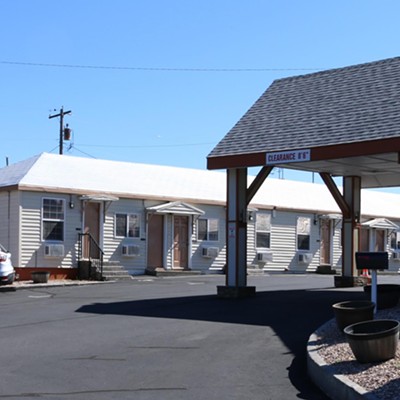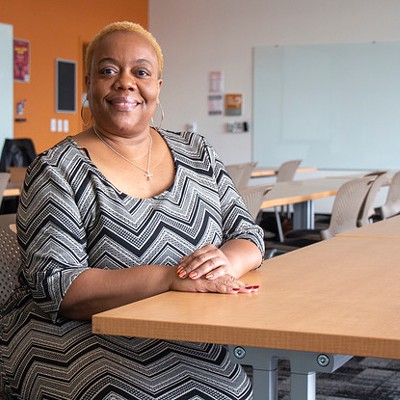OSU-Cascades inched one step closer to actualizing its planned expansion into a 10-acre site in southwest Bend on Monday, when City Council moved to affirm the two previous approvals of the school's site plan during an appeal hearing brought by the Truth in Site opposition group.
The decision, which Council is expected to formally vote on at its Oct. 15 meeting, marks the halfway point in an already lengthy land-use process. City staff and a Deschutes County hearings officer have already approved the site plan. If Truth in Site appeals City Council's decision—as the group's founder has indicated it will—the case will move to the Land Use Board of Appeals (LUBA) and then potentially on to the Circuit Board of Appeals and the Oregon State Supreme Court.
The five-hour hearing focused on four subjects—a City staff consolidation of the 20 "assignments of error" presented by Truth in Site's notice of appeal—master planning, parking, traffic and miscellaneous.
Bend Planning Manager Colin Stephens laid out each issue in succession, breaking down the perspective of City staff in each case. Following the staff presentation, the applicant (OSU) and the appellant (Truth in Site) alternated, offering their general and specific arguments.
The two sides' approaches had distinctly different flavors. The attorneys for OSU-Cascades were all business, focusing on technicalities in code and appeal procedure and leaning heavily on the prior application approvals from City staff and the hearings officer, while Truth in Site's attorney had a flair for dramatic, colorful language, interspersing humor throughout his arguments and even inviting the coalition's founder, Scott Morgan, to make a few remarks about his vision for a "university park" that would have an economic "multiplier effect."
"Why miss an opportunity to create a new and thriving economic center based on the university?" Morgan asked.
Issue: Master Planning
One of the primary arguments is what exactly is the legal definition of "master planning." OSU-Cascades says that it has complied with the code; opponents feel as if there isn't sufficient information about the overall plan for OSU-Cascades.
What has been particularly contentious is that beyond the 10-acre site it already owns, OSU has put earnest money on an adjacent 46-acre site, but not yet purchased it—and, as such, City staff arguemaster planning is not necessary.
"Under our code, that's not required," conceded Bend Planning Manager Colin Stephens during the staff report. Plus, he added, "That's not a very practical way to require development to happen."
Opponents have contended that OSU-Cascades should be required to "master plan" for the entire 56 acres it hopes—and, as they contend, plan—to own. They have gone so far as to accuse the college of going out of its way to avoid a planning process that would expose the incompatibility of the school with the surrounding community.
"Why has the city appeared to jump through hoops and do cartwheels to avoid doing master planning?" asked Jeffrey Kleinman, the attorney for Truth in Site, who also contended that artist renderings of a potential 56-acre site prove that the school is "putting the cart before the horse" and called waiting to do a master plan "a gateway to disaster."
City staff, though, compared planning for a site the applicant doesn't yet own to planning for a neighbor's property. Moreover, they claimed that the hearings officer's assertion that OSU-Cascades could create a non-binding master planning was inaccurate.
"It would be significantly binding," Stephens said. "To do anything different than what is in the master plan would require an amendment."
Steve Janik, the attorney for OSU-Cascades, also argued that City code referencing master planning only requires it if the property is more than 20 acres. Even if the college wanted to do master planning for the adjacent 46-acres, it does not have permission from the current landowner.
Issue: Parking
At first blush, parking appeared to be a straightforward issue. City code makes no specific requirements of a Parking Management Plan, only that one exists.
To devise its parking plan, OSU-Cascades hired a consulting company to calculate the necessary numbers of parking spots for its initial 1,900 students, faculty and staff; that number is just under 300. OSU also conducted internal considerations, looking at similar campuses (like University of Colorado-Boulder), which also has reached the same conclusion.
Even so, the argument focused on "mode splits," essentially, how many students will drive, bike or bus, and how many students will be in one place at one time.
The appellant argued that the school's approach to parking was too aspirational (in terms of numbers of carpoolers and bikers) and, ultimately, unrealistic.
Assistant City Attorney Gary Firestone said that the two sides represented two approaches to parking. One that encourages alternative means of commuting, and one that looks at current Bend commuting habits and sees mostly automobile traffic. While no one denied that Bend residents don't have a great track record with alternative modes of transportation, City staff emphasized that the college's approach is in line with the City's priorities.
The City also plans to check on parking after the college is established, and has the liberty to require more parking spots should they be needed.
OSU-Cascades took four separate approaches to reach its number of total parking spaces. Each approach brought it to a number just under 300 for the number of students, staff and faculty likely to be on campus at any given time. The analyses also took into consideration inclement weather and commute modality splits from comparable cities.
In all, the college estimates that about 30 percent of students will walk or bike to campus, while 20 percent will take public transit, 20 percent will carpool and about 26 percent will drive alone. These estimates, while based on mode splits from comparable schools in cold cities like Green Bay, Wisc., and Boulder, Colo., were adjusted to be more conservative.
"Millenials don't tend to drive single occupancy vehicles," OSU attorney Janik argued. "They tend to use other modes."
Kleinman, the attorney for Truth in Site, countered that Bend is not like those other cities, that "the transit habits are not there." He pointed to an anecdote provided by a witness for the opposition, who apparently took a photo at Central Oregon Community College on a day that an inch of snow was on the ground. The photo allegedly shows just four bikes and a crowded parking lot. He did not address the fact that COCC is on a large hill.
The Truth in Site attorney further argued that it is unwise to put the college in charge of monitoring its own parking situation.
"That's the fox guarding the hen house, or the beaver guarding the wood pile," Kleinman said.
Issue: Traffic
Much of the debate regarding traffic was hinged on the "aspirational" assumption made regarding parking. But Council did not seem to see these aspirations as problematic.
"If the code doesn't prevent us from trying these kinds of aspirational plans, I don't see what the problem is," said Councilor Victor Chudowsky, echoing sentiment expressed by Councilor Mark Capell who asked, "Wouldn't it be great if [the aspirational assumptions] were true?"
The Truth in Site attorney countered that the plan presented by OSU-Cascades simply isn't realistic.
"You have to meet all the needs of the campus," Kleinman said. "Wishing and hoping doesn't get you there."
The attorneys for OSU-Cascades also pointed out that the previous master planning process created for the Century Washington Center area the new campus would be built in already accounted for future traffic impacts.
Still, in an effort to mitigate congestion during the high traffic times caused by parents dropping off and picking up their kids at school, OSU-Cascades has agreed to build its start and stop times around the schedules of area schools.
Ultimately, City Council expressed sympathy for the concerns of neighbors and a desire for a master plan, but agreed that the site plan meets City code. Finding no reason to deny the application, Council moved to affirm the findings of the hearings officer and will vote on final language, including a few small changes, at the Oct. 15 meeting.



























